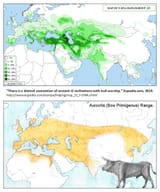Search Results
6/26/2025, 5:36:05 AM
>>17791243
Both.
>It has been hypothetised that the haplogroup-R Eastern Hunter-Gatherer people (perhaps alongside neighbouring haplogroup-J Caucasus Hunter-Gatherer tribes) were the first to domesticate cattle in northern Mesopotamia some 10,500 years ago. The Eastern Hunter-Gatherer tribes descended from Ancient North Eurasian mammoth hunters, and when mammoths went extinct, they started hunting other large game such as bisons and aurochs. With the increase of the human population in the Fertile Crescent from the beginning of the Neolithic (starting 12,000 years ago), selective hunting and culling of herds started replacing indiscriminate killing of wild animals. The increased involvement of humans in the life of aurochs, wild boars and goats led to their progressive taming. Cattle herders probably maintained a nomadic or semi-nomadic existence, while other people in the Fertile Crescent (presumably represented by haplogroups E1b1b, G and T) settled down to cultivate the land or keep smaller domesticates
>The analysis of bovine DNA has revealed that all the taurine cattle (Bos taurus) alive today descend from a population of only 80 aurochs. The earliest evidence of cattle domestication dates from circa 8,500 BCE in the Pre-Pottery Neolithic cultures in the Taurus Mountains. The two oldest archaeological sites showing signs of cattle domestication are the villages of Çayönü Tepesi in southeastern Turkey and Dja'de el-Mughara in northern Iraq, two sites only 250 km away from each others. This is presumably the area from which R1b lineages started expanding - or in other words the "original homeland" of Yamnaya
>>17791698
>The highest genetic diversity within haplogroup G of Anatolian Neolithic Farmers is found in the northern part of the Fertile Crescent, between the Levant and the Caucasus, which is a good indicator of its region of origin
Both.
>It has been hypothetised that the haplogroup-R Eastern Hunter-Gatherer people (perhaps alongside neighbouring haplogroup-J Caucasus Hunter-Gatherer tribes) were the first to domesticate cattle in northern Mesopotamia some 10,500 years ago. The Eastern Hunter-Gatherer tribes descended from Ancient North Eurasian mammoth hunters, and when mammoths went extinct, they started hunting other large game such as bisons and aurochs. With the increase of the human population in the Fertile Crescent from the beginning of the Neolithic (starting 12,000 years ago), selective hunting and culling of herds started replacing indiscriminate killing of wild animals. The increased involvement of humans in the life of aurochs, wild boars and goats led to their progressive taming. Cattle herders probably maintained a nomadic or semi-nomadic existence, while other people in the Fertile Crescent (presumably represented by haplogroups E1b1b, G and T) settled down to cultivate the land or keep smaller domesticates
>The analysis of bovine DNA has revealed that all the taurine cattle (Bos taurus) alive today descend from a population of only 80 aurochs. The earliest evidence of cattle domestication dates from circa 8,500 BCE in the Pre-Pottery Neolithic cultures in the Taurus Mountains. The two oldest archaeological sites showing signs of cattle domestication are the villages of Çayönü Tepesi in southeastern Turkey and Dja'de el-Mughara in northern Iraq, two sites only 250 km away from each others. This is presumably the area from which R1b lineages started expanding - or in other words the "original homeland" of Yamnaya
>>17791698
>The highest genetic diversity within haplogroup G of Anatolian Neolithic Farmers is found in the northern part of the Fertile Crescent, between the Levant and the Caucasus, which is a good indicator of its region of origin
Page 1
